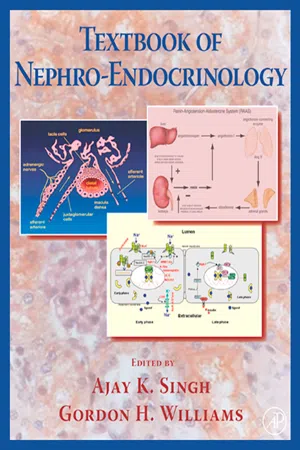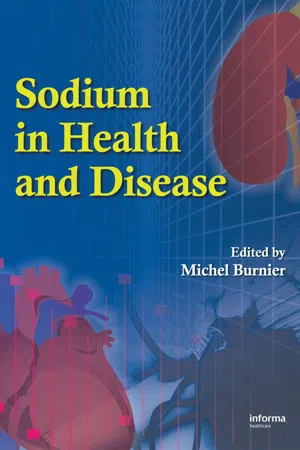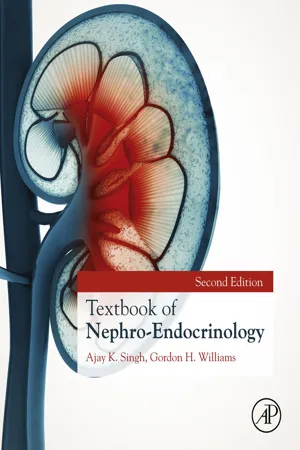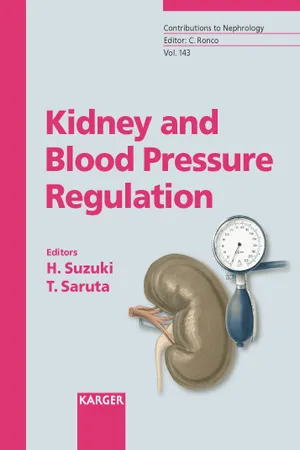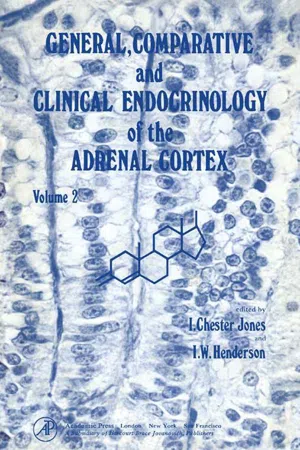Biological Sciences
Aldosterone
Aldosterone is a hormone produced by the adrenal glands that plays a key role in regulating blood pressure and electrolyte balance in the body. It acts on the kidneys to increase the reabsorption of sodium and water while promoting the excretion of potassium. This hormone is essential for maintaining proper fluid and electrolyte levels in the body.
Written by Perlego with AI-assistance
Related key terms
1 of 5
10 Key excerpts on "Aldosterone"
- eBook - PDF
- Elizabeth H. Holt, Harry E. Peery(Authors)
- 2003(Publication Date)
- Academic Press(Publisher)
THE RENIN–ANGIOTENSIN–Aldosterone SYSTEM As already described in Chapter 4, Aldosterone is an adrenal steroid that plays a pivotal role in maintaining salt and water balance.Aldosterone is secreted by cells of the zona glomerulosa and acts primarily on the principal cells in the cortical collecting ducts to promote reabsorption of sodium and excretion of potassium. It may be recalled that Aldosterone does not stimulate a simple one-for-one exchange of sodium for potassium in the nephron. Sodium reabsorption exceeds potassium excretion by the principal cells. However, because sodium and potassium are also regulated at other renal sites, the net effects of administered Aldosterone on sodium and potassium excretion in the urine differ in different physiological states. The Renin–Angiotensin–Aldosterone System 235 Figure 7 The effects of increases or decreases in blood volume or blood pressure on the relation between ADH concentrations and osmolality in the plasma of unanesthetized rats. Circled numbers indicate percentage change from normal (N). (Modified from Robertson, G. L., and Berl,T., In “The Kidney,” 5th Ed., p. 881, Saunders, Philadelphia, 1996, with permission.) N -10 -15 -20 +10 +20 +15 10 8 6 4 2 0 260 270 280 290 300 310 320 330 340 plasma osmolalit y (mOsm/kg) plasma ADH (pg/ml) hypovolemia or hypotension hypervolemia or hypertension Retention of sodium obligates simultaneous reabsorption of water by the nephron and expands the interstitial and vascular volume accordingly.The effects of aldos-terone to promote sodium retention by the kidney are augmented by similar effects on sweat and salivary glands and by a poorly understood effect on the brain that increases the appetite for sodium chloride. Aldosterone secretion is controlled by angiotensin II, whose complementary actions on a variety of target tissues play a critical role in maintaining the central pressure:volume reservoir. - eBook - ePub
- Ajay K. Singh, Gordon H. Williams(Authors)
- 2009(Publication Date)
- Academic Press(Publisher)
Chapter 24. Regulation of Aldosterone Production
Abstract- Introduction 361
- Aldosterone biosynthesis 361
- Factors regulating Aldosterone production 362
- Diseases of Aldosterone production 371
- Summary 375
- References 375
Aldosterone is a key regulator of blood volume and pressure such that abnormalities in its production contribute to human diseases including hypertension, congestive heart failure and salt-wasting forms of congenital adrenal hyperplasia. The secretion of this steroid hormone is regulated primarily by angiotensin II and serum potassium levels, which increase Aldosterone production both acutely, through stimulation of multiple signaling events, and chronically by regulating the expression of steroidogenic enzymes, in particular, Aldosterone synthase (CYP11B2). A variety of cell culture model systems have been used to help define the mechanisms that regulate Aldosterone biosynthesis. These models arise from different species and have been studied under diverse in vitro conditions; each of which may contribute to discrepancies in research findings discussed in this chapter. The importance of Aldosterone in maintaining electrolyte balance and as a common cause of hypertension support the need for continued research to help define the detailed mechanisms controlling both normal and pathologic synthesis of Aldosterone.24.1. Introduction
Aldosterone represents the primary mineralocorticoid produced by the adrenal gland and specifically within the outer adrenocortical cells of the glomerulosa layer. The need for the structural zonation of the adrenal cortex as a mechanism to control Aldosterone production is apparent when one considers that the amount of Aldosterone needed to control salt balance is 100–1000-fold less than the amount of cortisol needed to control carbohydrate metabolism. The unique histology of the three concentric zones of the mammalian adrenal cortex led to the names zona glomerulosa, zona fasciculata and zona reticularis (Arnold, 1866 - eBook - PDF
- Michael Burnier(Author)
- 2007(Publication Date)
- CRC Press(Publisher)
7 Aldosterone and Mineralocorticoid Receptors Nicolette Farman Faculte ´ de Me ´decine, Xavier Bichat, Paris, France INTRODUCTION The steroid hormone Aldosterone plays a major role in the control of blood pressure and extracellular volume homeostasia (1–4). Aldosterone is synthesized in the glomerular zone of the adrenal cortex in response to hyperkalemia or sodium depletion, as the end point of activation of the renin-angiotensin system. Its biosynthesis from cholesterol depends on several enzymes, many of which belong to the cytochrome P 450 family; the biosynthetic pathways, their regulation and pathophysiological aspects will not be exposed here (see Ref. 5 for a recent overview). Considerable work has been achieved to improve the understanding of the molecular and cellular events involved in Aldosterone actions, in normal as well as in pathological situations (1–4,6–9). It is well established that Aldosterone stimulates renal sodium reabsorption and potassium excretion. These effects are observed one to two hours after hormone administration, a delay necessary for hormonally mediated activation of sodium transporters and regulation of transcription of target genes. As illustrated schematically in Figure 1, Aldosterone binds to the mineralocorticoid receptor (MR), which is a ligand-dependent transcription factor (6,10,11); once translocated into the nucleus, the hormone–receptor complexes bind to glucocorticoid response elements (GRE) within the promotor region of early Aldosterone-induced genes to modulate their transcription (there is no mineralocorticoid-specific response element; mineralocorticoid, glucocorticoid, androgen as well as progesterone receptors bind to the same GREs). This will trigger an increase in the activity and number of sodium transporters or channels. - eBook - ePub
- Ajay K. Singh, Gordon H. Williams(Authors)
- 2017(Publication Date)
- Academic Press(Publisher)
Chapter 24Regulation of Aldosterone Production
Silvia Monticone1 , 2 , William E. Rainey2 , Wendy B. Bollag3 , and Carlos M. Isales31 University of Torino, Torino, Italy2 University of Michigan, Ann Arbor, MI, United States3 Medical College of Georgia, Augusta, GeorgiaAbstract
Aldosterone represents the major mineralocorticoid hormone in all mammals. It is synthesized in the outer layer of the adrenal cortex, called the zona glomerulosa, and plays a pivotal role in the regulation of blood pressure and electrolyte homeostasis, through the absorption of sodium and water. Aldosterone production is tightly regulated through the selective expression in the zona glomerulosa of CYP11B2 , encoding Aldosterone synthase, and the centripetal blood flow in the adrenal cortex, which prevents the precursors of Aldosterone in the zona fasciculata from accessing Aldosterone synthase. The main physiological stimuli of Aldosterone secretion are angiotensin II, potassium, and adrenocorticotropin. Aldosterone production can be regulated acutely (within minutes of stimulation), by increased expression and phosphorylation of the steroidogenic acute regulatory protein (StAR), and chronically (hours to days) through increased expression of CYP11B2.Keywords
Angiotensin II; Aldosterone; ATP1A1; ATP2B3; CACNA1D; CYP11B2; KCNJ5; Phospholipase C; Phospholipase DOutline1. Introduction 2. Aldosterone Biosynthesis 3. Factors Regulating Aldosterone Production 3.1 The Renin–Angiotensin–Aldosterone System 3.1.1 Physiology of the Renin–Angiotensin–Aldosterone System 3.1.2 AngII-Regulated Intracellular Signaling Pathways 3.1.3 Chronic Effects of AngII 3.2 Potassium 3.2.1 Effects of Potassium on Aldosterone Production 3.2.2 Potassium-Regulated Intracellular Signaling Pathways 3.2.3 Chronic Effects of Potassium 4. Adrenocorticotropic Hormone - eBook - ePub
- Anthony W. Norman, Helen L. Henry(Authors)
- 2014(Publication Date)
- Academic Press(Publisher)
2-19 . The mineralocorticoids mediate their actions on ion balance principally in the kidney, and also to some limited extent in the salivary glands, gut, and sweat glands.In the kidney, the actions of the Aldosterone result in an increased cortical collecting tubule reabsorption of Na+ with a concomitant secretion of K+ . Only a fraction of the Na+ filtered by the glomerulus is actually reabsorbed as a consequence of Aldosterone’s action. However, this fraction can effect significant consequences on electrolyte balance.The steroid hormone Aldosterone by binding to its nuclear receptor produces biological responses via stimulation of selected gene expression related to kidney tubule Na+ transport. The focus of Aldosterone is on the mucosal cells of the kidney’s cortical collecting duct (see Figure 15-2 ). In the absence of Aldosterone, there is only a minimal basal uptake of Na+ from the lumen (extracellular) side of the collecting duct cell by the Na+ permease. Figure 15-5B illustrates the four steps in the cortical collecting duct cell which are operative in the presence of Aldosterone. The presence of Aldosterone binding to its nuclear receptor stimulates the gene transcription of several proteins that are essential to supporting the overall entrance of Na+ into the cell via a Na+ permease. Since the extracellular concentration of Na+ is significantly higher (~140 mM) than the intracellular concentration of Na+ (~10mM; see Table 15-3 ), the Na+ in the cortical collecting duct cell’s cytosol must utilize the Na+ /K-ATPase (see Figure 15-5B ) to transfer the Na+ across the peritubular cell membrane, against a concentration gradient, and release it into the extracellular fluid.E Atrial Natriuretic Protein System
1 Introduction
The heart and brain are the source of a family of peptide hormones referred to as the atrial natriuretic peptide (ANP) system. Cardiac ANP is secreted by atrial cells of the heart following volume expansion of the heart or in circumstances of elevated blood pressure. Table 15-7 - eBook - PDF
- H. Suzuki, T. Saruta, Claudio Ronco(Authors)
- 2004(Publication Date)
- S. Karger(Publisher)
Suzuki H, Saruta T (eds): Kidney and Blood Pressure Regulation. Contrib Nephrol. Basel, Karger, 2004, vol 143, pp 90–104 Role of Aldosterone Blockade in the Management of Hypertension and Cardiovascular Disease Murray Epstein Department of Medicine, University of Miami School of Medicine, Miami, Fla., USA Aldosterone is a major regulator of extracellular fluid volume and the major determinant of potassium metabolism [1–5]. These effects are mediated by the binding of Aldosterone to the mineralocorticoid receptor in target tissues, primarily the kidney. Volume is regulated through a direct effect on the collecting duct, where Aldosterone causes an increase in sodium retention and an increase in potassium excretion. The reabsorption of sodium ions produces a fall in the transmembrane potential, thus enhancing the flow of positive ions, such as potassium, out of the cell into the lumen. The reabsorbed sodium ions are trans-ported out of the tubular epithelium into the renal interstitial fluid and from there into the renal capillary circulation. In recent years, there has been a paradigm shift with respect to our under-standing of Aldosterone’s widespread effects on the heart, the vasculature, and the kidney [6–11]. The endocrine properties of Aldosterone have assumed a broader perspective involving nonclassic actions in nonepithelial cells found in nonclassic target tissues, including the heart, the vasculature, and the kidney [6, 9–17]. There is increasing evidence that Aldosterone can have an effect on vascular remodeling and collagen formation, and a nongenomic action to modify endothe-lial function. Among the most intriguing effects of Aldosterone are its impact on fibrosis and activity associated with a cell surface receptor in certain target tis-sues, including endothelial cells [6, 7, 18–21]. These actions contribute substan-tively to the pathophysiology of congestive heart failure, including its progressive nature, as well as progressive renal dysfunction. - eBook - PDF
Neuroendocrinology
Volume I
- Luciano Martini, William F. Ganong(Authors)
- 2013(Publication Date)
- Academic Press(Publisher)
V. Summary The regulation of Aldosterone secretion is a complex multifaceted sys-tem. Three mechanisms have been clearly shown to stimulate Aldosterone secretion by a direct adrenal effect: ACTH, the potassium ion, and angio-tensin II. Acute administration of ACTH can stimulate Aldosterone secre-tion in most species. The importance of its role, however, varies from species to species, ranging from the frog, where it is the main regulator of Aldosterone secretion, to man, where ACTH plays a more permissive role by maintaining adrenal weight and metabolism. The potassium ion is important for the biosynthesis of Aldosterone. A deficiency of potassium reduces the effect of other stimuli. Although potassium loading associated with an elevated serum potassium concentration stimulates Aldosterone secretion, an increase in serum potassium is not the mechanism by which many physiological stimuli increase Aldosterone secretion. There is a great deal of evidence in dog and man indicating that the renin-angiotensin system is the major regulator of Aldosterone secretion. In the sheep and rat, however, the evidence is contradictory. In fact, the data suggest another as yet undefined regulatory mechanism. The role of the central nervous system is the most controversial. It is the opinion of this author that the literature does not support an important physiological role for the central nervous system except through the regulation of ACTH release. REFERENCES Anderson, C. H., McCally, M., and Farrell, G. L. (1959). The effects of atrial stretch on Aldosterone secretion. Endocrinology 64, 202-207. Ayres, P. J., Gould, R. P., Simpson, S. A., and Tait, J. F. (1956). The in vitro demonstration of differential corticosteroid production within the ox adrenal gland. Biochem. J. 63, 19. 436 PATRICK J. MULROW Baisset, A., Douste-Blazy, L., Montastruc, P., and Valdigine, P. (1962). Recherches sur la regulation volumetrique de la sérétion de TAldosterone. - eBook - PDF
Recent Progress in Hormone Research
Proceedings of the 1965 Laurentian Hormone Conference
- Gregory Pincus(Author)
- 2013(Publication Date)
- Academic Press(Publisher)
I believe the response even in adrenalectomized animals is variable, angiotensin II sometimes producing sodium retention and sometimes sodium excretion. D. Sharma: I would like to add a piece of information and possibly a contributory mechanism for the control of Aldosterone biosynthesis. During our rather extensive investigations on the in vitro biosynthesis of Aldosterone in sheep, bovine, and guinea pig adrenals, as well as in a tumor from a patient with primary aldosteronism, it appeared that the biosynthesis of Aldosterone follows from corticosterone to 18-hydroxy-corticosterone and then to Aldosterone. We were then checking as to what contributory factors may stimulate the Aldosterone biosynthesis. It was found that calcium (Ca+ + ) increases the 18-hydroxycorticosterone formation by almost seven- to eightfold in the step from corticosterone to 18-hydroxycorticosterone. In addition, to our surprise, we noted that if we add sodium ions, the substrate 18-hydroxycorticosterone is primarily converted to 18-hydroxy-ll-dehydrocorticosterone, not to Aldosterone in presence of TPN; the increase was almost sixfold. The identity of 18-hydroxy-ll-dehydrocorti-costerone was checked by converting it to the etiolactone by periodic acid oxidation and also forming the same etiolactone from 18-hydroxycorticosterone by first oxidizing 18-Corticosterone Ca + -Inhibition-By 18-OH-Corticosterone _18-OH-ll-Dehydro-corticosterone Aldosterone Na K hydroxycorticosterone with periodic acid and then with chromic acid. Investigations on the effect of several steroids and other compounds on the formation of Aldosterone re-vealed that, of all the 20 or 25 different compounds we checked, only 18-hydroxy-ll-dehydrocorticosterone inhibited the formation of 18-hydroxycorticosterone. We have summarized this information in the accompanying diagram. The conversion of corticosterone to 18-OH-corticosterone is increased by C a + + , and - eBook - PDF
- C. E. Flück, W. L. Miller, Flück, Miller(Authors)
- 2008(Publication Date)
- S. Karger(Publisher)
Flück CE, Miller WL (eds): Disorders of the Human Adrenal Cortex. Endocr Dev. Basel, Karger, 2008, vol 13, pp 133–144 The Role of Adrenal Steroidogenesis in Arterial Hypertension Markus G. Mohaupt Division of Hypertension, Department of Nephrology/Hypertension, University of Bern, Berne, Switzerland Abstract Adrenal Aldosterone production, the major regulator of salt and water retention, is discussed with respect to hypertensive diseases. Physiological Aldosterone production is tightly regulated, either stimulated or inhibited, in the adrenal zona glomerulosa by both circulating factors and/or by locally derived endothe-lial factors. Arterial hypertension caused by volume overload is the leading clinical symptom indicating increased mineralocorticoid hormones. Excessive Aldosterone production is seen in adenomatous disease of the adrenals. The balance between stimulatory/proliferative and antagonistic signaling is disturbed by expression of altered receptor subtypes in the adenomas. Increased Aldosterone production without a detectable adenoma is the most frequent form of primary aldosteronism. Both increased sensitivity to agonistic signals and activating polymorphisms within the Aldosterone synthase gene (CYP11B2) have been associated with excessive Aldosterone production. 17 -Hydroxylase deficiency and glucocorticoid-remediable aldosteronism can also cause excessive mineralocorticoid synthesis. In contrast, the severe form of pregnancy-induced hypertension, preeclampsia, is characterized by a compromised volume expansion in the presence of inappropriately low Aldosterone levels. Initial evidence suggests that com-promised CYP11B2 is causative, and that administration of NaCl lowered blood pressure in pregnant patients with low Aldosterone availability due to a loss of function. - I. Chester Jones, I. W. Henderson, I. Chester Jones, I. W. Henderson(Authors)
- 2013(Publication Date)
- Academic Press(Publisher)
These changes may be secondary to altered renal haemodynamics resulting from the effects of Aldosterone on sodium and potassium metabolism. The changes are not due to the hypertension since in the majority of patients with essential hypertension both plasma renin activity and angiotensin levels are normal. These hormones are considerably affected in normal individuals by physiological adaptations, such as posture and exercise but in the presence of aldosteronism these adaptive changes fail to occur. Various diagnostic tests have been worked out based on these observations (Conn et al., 1964). However, other factors which normally influence Aldosterone secretion, corticotrophin and angiotensin for example, sometimes affect secretion in primary aldosteronism, and diurnal fluctuations in secretion have also been observed (Kem et al., 1972). G MANAGEMENT Primary aldosteronism may be managed medically or surgically. The decision depends largely on the patients’ general fitness for operation, the radiographie demonstration of an adenoma in one gland and on the likelihood of the adenoma being malignant. Medical treatment using the Aldosterone antagonist, spironolactone or antihypertensive therapy, along with a potassium-sparing diuretic such as amiloride, has often been very successful (Kremer et al., 1973). Such treatments must, however, be lifelong and there are potential hazards and side effects from the drugs used. Operative removal of a secreting adenoma offers, on the other hand, the chance of a complete and permanent cure. In each individual patient, some careful consideration of the best treatment is needed even after firm diagnosis. 2 Syndromes resembling primary aldosteronism A number of conditions resembling primary aldosteronism occur without detectable excessive secretion of Aldosterone or elevation of plasma Aldosterone concentration. These may be due to excessive adrenal secretion of substances having mineralocorticoid properties
Index pages curate the most relevant extracts from our library of academic textbooks. They’ve been created using an in-house natural language model (NLM), each adding context and meaning to key research topics.

